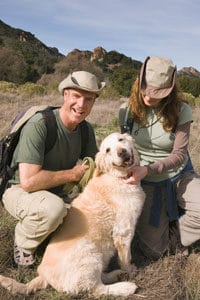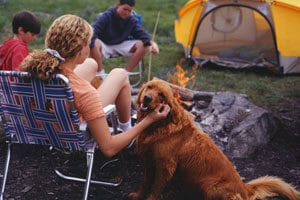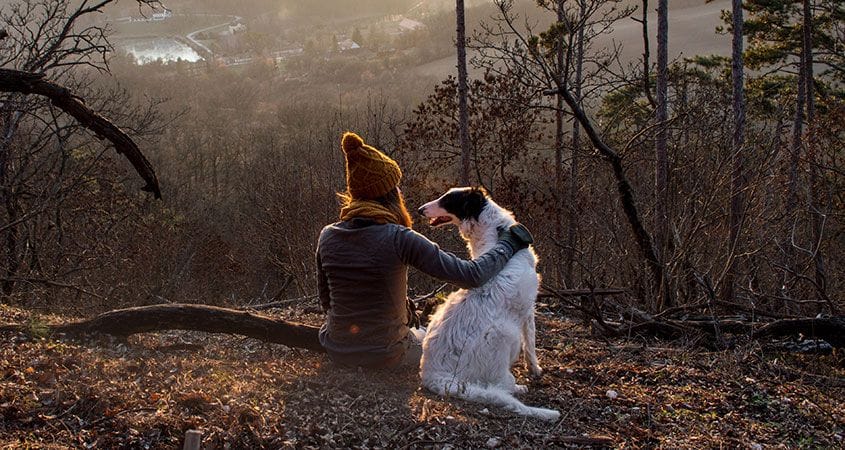If you’re like many dog owners, you probably love spending time in the great outdoors, but before you hit the great outdoors with your four-legged pal, consider these expert-approved outdoor tips.
Tips to Follow
Know before you go
Whether you plan to camp with your pup in an RV park, pitch a tent at your favorite lakeside campground or hike several miles to an idyllic destination, make certain you know the rules and regulations related to dogs, according to Jon Asher, a Santa Fe, New Mexico, resident who runs online canine outfitter company Wild Mountain Online.
“First, find out if dogs are allowed at the campground,” says Asher, who has camped countless times with his Labradors, ten-year-old Rio and four-year-old Lily, and plans to do another cross-country trip this summer. “If they are (allowed), ask about the rules, like where they’re allowed and where they’re not, what to do with their waste, and whether they have to be on leash.”
Unfortunately, quite a few national parks restrict access to dogs, says Westlake Village, California, author Ellen Eastwood, who wrote The Trail Hound’s Handbook: Your Family Guide to Hiking with Dogs. State parks and national forests, however, are a bit more lax, she says.
“Make sure you know where you’re going and if your dog is welcome,” she advises. “The national parks and places where there’s a protected balance of nature, like Yosemite and Yellowstone, are very explicit about where dogs are allowed and where they’re not, and their website is good about being thorough about each park. State parks and national forests are a lot more inviting for dog owners, but there are still regulations.”
Pest Prevention
Protect your pal from troublesome fleas, ticks, mosquitoes, heartworm and other outdoor pests by applying flea and tick preventives and giving her heartworm medication well in advance of your trip, Eastwood advises.
“Talk to your vet ahead of time about vaccinations against Lyme disease and heartworm,” in addition to making sure the pup is up to date on her rabies shots, she says. “Apply the flea and tick medication in advance so it has time to cover their whole body, and brush your dog after hikes, checking behind their ears, under the collar, armpits – anywhere a tick might hide.”
Don’t forget about larger pests. Always put away your dog’s food and water at night, in a secure container away from easy access, unless you want bears wandering around your campsite.
Train, Train, Train

Basic obedience — with recall (“Come”) being the most important command to master — is a concept your pup should understand well before you hit the trail, Asher says. Being in control of your pup will keep her safe, particularly if camping in an unfamiliar area or one with wildlife or other loose dogs.
“Obedience training is critical,” he says. “If they’re well-trained, they’ll be less likely to be obnoxious and do things like growling or barking at other campers, or even fighting with other dogs.”
The commands your dog should know include “Sit”, “Stay”, “Down”, “Come”, and “Leave It”, and your dog should be able to walk properly on a leash. Even if your pup has perfect manners, Eastwood advises keeping her on leash at all times.
“I’ve tried letting my dog off-leash in the past, but there are just so many things that can go wrong,” she says. “If there’s a loose dog, for instance, I know my dog will sit and stay by my side instead of trying to jerk away and run off. It’s best to keep your dog in check,” she says. “That way, the situation stays a little calmer.”
Condition Your ‘Couch Puppy’
In addition to checking your dog’s basic obedience skills, also make certain she’s physically fit for your upcoming outdoor adventure, Eastwood advises, particularly if she spends most of her time lounging inside and playing on a manicured lawn.
“Some dogs might not be ready to hop up and take a five mile hike, so it makes sense to do a little conditioning,” she says. “Look at it as you would a person. Is your dog is young or old? Overweight? Does she have arthritis, or is she generally healthy? If you have a couch puppy, it would be a good idea to check with your veterinarian.”
Young dogs have seemingly boundless energy, but even they can injure themselves if they are not used to uneven terrain. Explains Eastwood, “They have growing bones and can possibly hurt themselves by being a little too active on the trail, stepping on rocks and things,” adding that it takes time to develop protective calluses on their paw pads. “Take it slow and condition your dog on nature paths before tackling elevation gains or hiking through rocky terrain.”
Use caution with older dogs, too. “Know what your dog is capable of,” she says. “Remember that with dogs, you don’t always know when they’re in distress. They have a very high threshold for discomfort. A walk could be getting to a dog’s joints, but she’s not going to tell you until the next day when she’s sore and doesn’t want to get up and go out.” Senior dogs will benefit from joint health supplements. Consult your vet.
Pack a Doggie Bag

When you pack your backpack, assemble a pack for your pooch, too. It should include essentials, like pre-measured food stored in plastic baggies or an airtight container, food and water bowls, a canine first aid kit, basic grooming tools, poop bags, an extra leash and collar with identification tags, and bedding.
“Put all the dog’s gear in a dog backpack,” Asher says. “Dogs love to have a job to do, so put your pooch to work carrying her own camping supplies – but make sure you get her used to wearing it before you go.”
The pack can also include extras, like dog-safe sunscreen, blinking LED collar lights, booties, a high-visibility jacket and a life vest for water adventures, he continues. “Always bring a favorite toy, like a Frisbee or other retrieving toy,” he adds. “Something familiar will help the dog feel more comfortable wherever you’re camping.”
Contented Canine
Most — if not all — types of dogs make excellent camping companions, but some breeds, such as snub-nosed brachycephalic breeds like pugs and bulldogs, will need extra attention, Eastwood says. “All dogs love to be outside, but there are things to think about… A dog with a shorter snout is not as well-equipped to cool herself, so she’s going to have more trouble (with) breathing and panting.”
Snub-nosed or not, when camping with your canine pal, make certain you provide plenty of clean water, particularly when you’re hiking or playing in the sun. “If you’re getting thirsty, your dog is probably already way past thirsty,” she says. “If you can imagine breathing through your own mouth through an entire hike, you’d get really parched. Same with dogs.”
Also provide a comfy bed or blanket inside your trailer or tent for cooling off and snoozing, Asher says. “Rio usually sleeps in the tent right by the door,” Asher says. “He likes to guard and protect us, so he hangs out in the vestibule and keeps watch. That’s his spot.”
With some planning and preparation, camping with your dog offers an easy opportunity to bond with your four-legged friend, enjoy the great outdoors and experience the beauty of Mother Nature together.
“Whatever you do, use common sense,” Eastwood says. “And have fun!”
What is your favorite dog-friendly camping spot? Share it with us in the comments.











